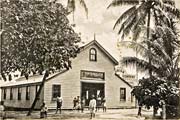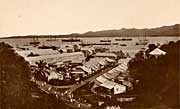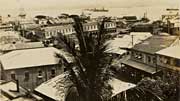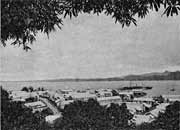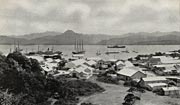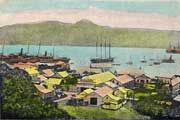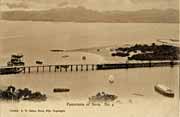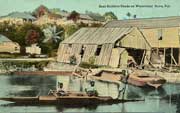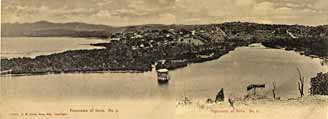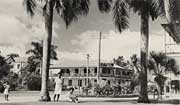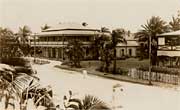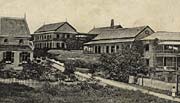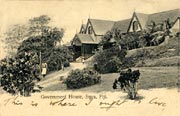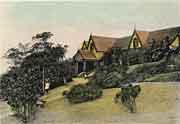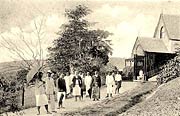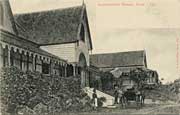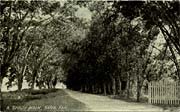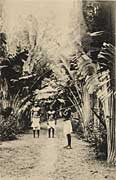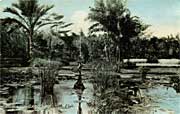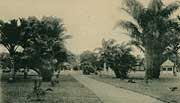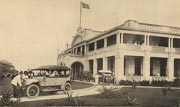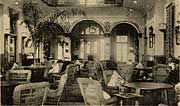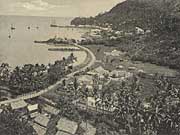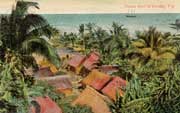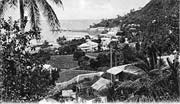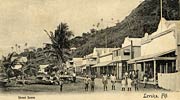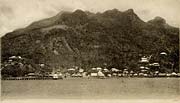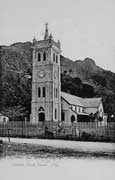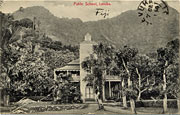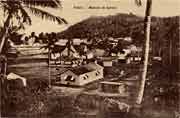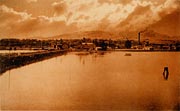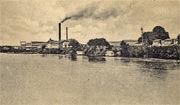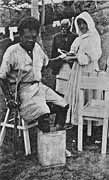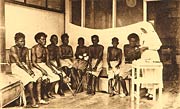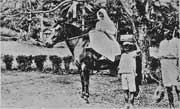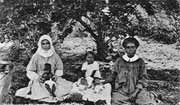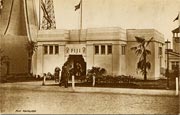"Panorama of Suva. No. 1". Publisher F.W. Caine, Suva, Fiji (#174853).
Unused and undated, but the serial number may provide a clue to its having been taken in 1885. This was not long after the establishment of Suva township, and it is clear that this photograph was taken at a very early date in the town's development.
The view appears to have been taken from the top of the CWM Hospital Hill, looking southwest, since there the mountain range to the northwest of Suva is not visible in the background, as would be the case if it were taken from further south, for instance in Toorak or from Flagstaff (see harbour view below).
This is a divided-back postcard, which indicates that it was printed no earlier than 1906, when the regulations were changed to permit this. However, this does not preclude any of the above comments regarding when I believe it was taken, as images were printed again and again. By 1906 Suva would have looked very different from this (see panoramic shots below).
"View across Harbor, Suva".
Publisher: J.W. Waters, Suva, Fiji (#72381). Original Collection: Mrs Amy Wager, 1904.
Addressed to "Mrs George Wager, 3 Hurlingham Villas, Ashley Hill, Bristol, England." Bears the inscription on the front: "Am sending these for your album"
Suva Harbour.
Publisher: Stinson Studio #11. Original Collection: W.J. & R.M. Ewins.
Postmarked: 1912. Addressed to "Mrs W.J.Ewins, Mango [Mago] Island, Fiji", message signed "Millie Harker". For a short time W.J. managed Mago for the owner, Mr Borren.
This photo, like the next one, appears to have been taken from Flagstaff Hill.
"Suva, Fiji". Publisher Co-Operative (Stinsons) #128.
Unused and undated, but Stinson's was operating under that name during the late 1920s and 1930s, from which date this comes.
The view appears to have been taken from the top of Flagstaff Hill, looking northwest across the town and harbour toward the mountain range to the northwest.
"The Harbour, Suva, Fiji".
Published by The Rose Strereographs, Sydney & Melbourne.The "Rose" Series De Luxe, P 10013. Unused and undated but probably about 1920.
Like the previous picture, the view is looking northwest across the town and harbour toward the mountain range to the northwest, but the angle of view is steeper and it was probably taken from closer into town.
"Approach from Wharf to Main Business Center of Suva, Fiji."
Publisher J.Butler, Suva, Fiji. Made in USA. No date, divided back indicates that it was post-1906 but very probably not long after that date.
I am unable to identify where this was taken, my best guess is that the photographer was standing on Nubukalou Creek Bridge, looking toward the T-intersection of Thomson St. with Marks St. on the right and (now) Usher St on the left. But this is speculative,
"Street scene, Suva."
Photographer/publisher Harry Gardiner (#S.K.2337). Original Collection: W.J. & R.M. Ewins."Post Card" is printed on the back in French, English, German, Italian, and Greek. The presence of German, and the stage of development of the street, both suggest a pre-1914 date.
Though not identified in the photograph, this is Thomson St near Nubukalou Creek (taken from Map Ref A). Note the railway (tram?) line. The large building on the right with the arched top and extended awning was Brown & Joske & Hedstrom, which in 1902 amalgamated with R.Bentley & Co.to become Morris, Hedstrom Ltd. In 1920 MH's moved into the large building that it still occupies today, a little further along the street on the bank of Nubukalou Creek. This had been originally built by Henry Marks & Co in 1893.
"Thomson Street, Suva, Fiji."
Photographer/publisher unknown. Used, but stamp removed and with it the postmark & date. Addressed to Hugo de Bussiere, Ocean Beach Post Office, San Diego, California USA., and the pedestrian message signed "Mr & Mrs Purnell".
This is almost the same view as that in the photo above, but taken from street level. The remarks made in the caption above therefore all relate to this also. The business name on the building next to Brown & Joske appears to be "Salter Docke & Co.", but I know nothing of this firm. Through the railings of the Nubukalou Creek Bridge can be seen the "Suva Soda Water Factory" but the name of the firm to its left is impossible to make out.
"Main Street, Suva, Rickshaws in Foreground". Publisher anonymous Pacific Island Series 1 of 10.
Unused postcard. Undated, divided back, probably between 1904 and 1910. The photographer stands in Thomson Street, looking toward the point where Renwick Road joins Thomson Street to become Victoria Parade. On the near left corner The Triangle, with the big ivi tree under which Suva was inaugurated as the Capital (Map Ref. F). This photograph is interesting on a number of levels. It documents the use of rickshaws in Suva, pulled by Fijians. The first of these were imported in January 1904, and were stationed at the Triangle and at intervals along Victoria Parade (ref. Stephenson p.132-4). On the right of the picture is ... nothing! Or rather, the sea. This shows clearly how Victoria Parade was indeed the "main street running along the waterfront" mentioned in early accounts, before the reclamation of land commenced. Today, of course, it is not a waterfront road until it becomes Queen Elizabeth Drive, past the Grand Pacific Hotel toward Nasese. Its continuity with Renwick Road explains how both this and the preceding picture could bear the title "Main Street".
"The Triangle, Victoria Parade, Suva". Publisher A. Mills, Suva.
Unused postcard, divided back. Undated, early 1900s. This photograph was again taken from Thomson Street; on the left is The Triangle, on the right the big ivi tree mentioned in the previous caption. The Fijian man carrying a log in the foreground is an enigma, but from the various unoccupied "helpers" standing around watching him, it may be that some sort of project was under way, perhaps in The Triangle.
"Coronation Presentations. The Fijian gift."
Unused and undated, but undivided back so pre-1906. No publisher listed, but from the characteristic typescript on the back, it is clearly one of A.M. Brodziak's cards (see Stephenson p.33).
These gifts, apparently presented at Government House in Suva, could only have been for the Coronation of King Edward VII in 1902, given the date of the card.
"Gala Day, Suva, Fiji". Publisher anonymous, Art Series - Copyright.
Used and dated Sept. 10 - 07, Addressed on verso to Chas Maskell, Esq., 16 O'Connell St., Sydney, NSW, Australia. Message on face of card.
This was a cricket match in Albert Park in the early 1900s (Stephenson note p.104). The proximity of the sea shows that the reclamation of land on which the Grand Pacific Hotel and all of the buildings between that and the Old Town Hall were built had yet to be undertaken.
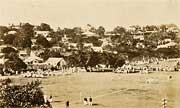
"Suva from Grand Pacific Hotel, Fiji".
Photographer Harry Gardiner (#83), published for him by The Rose Stereographs, Armadale, Victoria.
The view is over Albert Park in the 1920s, the reclamation having taken place and the Grand Pacific Hotel well established. This photo was taken at right angles to the one above, as the GPH is on the seaward side of the park.
It appears that this was taken on some sort of girls' sports day, since there are several young girls on the right of the photo, in the middle of the grounds, and groups of schoolgirl spectators on the left and right distance of the grounds.
"Victoria Parade, Suva, Fiji". Publisher: Co-Operative (No.125).
Unused and undated, but the flivver parked on the right side and those just visible approachig on the left suggest the 1920s. This view is in exactly the opposite direction to that in the previous picture. The Triangle with its large ivi tree can be seen in the centre distance.
"Victoria Parade, Suva, Fiji". Publisher: Co-Operative.
Message in pencil from "Grnama" to "Joan", but not addressed or posted, Undated, but it appears to be about the same period as the view above. it is taken in exactly the opposite direction, from a spot about halfway down that picture. The roof of the building in the left foreground of this picture is the far end of the building in the right foreground of the previous picture.
There appears to be a Fijian performance of some sort occurring in the middle distance, about the centre of this scene.
"Street Scene, Suva, Fiji".
Unused and undated, but from the1920s. Photographer Harry Gardiner, published by The Rose Stereographs, Armadale, Victoria, The "Rose" Series De Luxe.
Curiously, this postcard has the scene reversed, with the lettering on the buildings back to front, but that obviously didn't deter its sale, presumably to tourists who didn't care. I have reversed it again so that it reads correctly. The view here is from Victoria Parade looking along Renwick Road. The ivi tree at the point of the Triangle is on the left. A.J.Swann's Chemist and the Bank of NZ are clearly seen on the right. The bland title fails to tell us what the occasion was, and it clearly was a celebration of some sort to have attracted such a large crowd.
"Central Suva, Fiji". Publisher: Co-Operative. Copyright. (No.3B214-N).
Unused and undated, but from the1930s car, the photo could date from any time after that into the 1950s - certainly this is exactly how the scene looked through the 1950s
The view here is from Victoria Parade, and looks toward where that street merges with Renwick Road. The Triangle with its ivi tree is out of frame on the left. A longer view of the same scene was published (almost certainly by the same publishers) in the 1930s. The sentry-box in which the traffic policeman stands is in both photos, and is the same one seen from the opposite direction in a much-reproduced picture from the 1950s. The entire block on the right ofthe picture has been reconfigured progressively since the end of the 1950s. A.J.Swann's Chemist and Noel Levy's Watchmaker and Curio store (both visible here) occupied a building where Caines Jannif photography store now stands. On the left of the picture can just be seen Boots the Chemist, now Proud's Jewellers. The roof of the Bank of NZ was a frequently-used vantage point for phototgraphs of The Triangle and of the buildings opposite, along Thomson Street.
"Main Street, Suva, Fiji". Colour-printed postcard. Published by Arnold & Co., Suva.
Posted on September 7th, 1911, to "J.Mitchell Esq. C/o Messrs Laery & Co Ltd, Wellington", with the message "This is a very interesting little place - but awfully hot. Levuka is much prettier. Kind regards. [signature indecipherable]"
This is the common view of Renwick Road, from The Triangle looking northeast up Renwick Road (from Map Ref. F). This Arnold & Co. publication is almost certainly a drawing taken from J.W.Waters photograph (Stephenson Fig,163), which was taken before the end of 1909, when, as Stephenson (p.187) points out, the Fiji Times office moved from the left-hand near corner (the position later occupied by Boots the Chemist and now by Prouds Jewellers). The building with the "Paint" sign, on the corner of Pratt St., was Sturt, Ogilvie & Co., which as mentioned above acquired the Henry Marks building further up the street in 1901. There is now a car-park on this corner. The awning on the near right-hand corner belongs to A.J.Swann & Co., Chemists, now owned by Caine's Jannif.(Map Ref. F)
"Pratt Street, Suva".
No publisher. Used and dated Feb 9, 1925, addressed to Mr & Mrs John Clegg, 5241 Manila Ave, Oakland, Calif, USA. Posted from Rotorua, New Zealand, two George V. 1/2d. stamps.
This photograph may well have been taken well before its postal date, even perhaps as much as twenty years earlier. Postcard photographs were frequently recycled for decades in Fiji.
Pratt Street turns southeast out of Renwick Road. This photo is taken looking southeast up the road (Map Ref H). The large stone building just visible on the near left of the picture is the Roman Catholic Sacred Heart Cathedral, consecrated in 1885. What is visible here is the incomplete east tower.
"Roman Catholic Cathedral, Suva".
Publisher: A.M.Brodziak & Co, Suva, Fiji. Unused and undated, but undivided back so definitely pre-1906
Taken looking diagonally across Pratt Street from a point north and east of the previous photograph. This is an early photo of the Roman Catholic Sacred Heart Cathedral,with the west and east towers at their firs stage, as in the previous photo.
"Catholic Church, Suva".
Publisher: Co-Operative #3B233-N. Unused and undated, but probably during the 1930s — certainly a lot later that the previous photograph.
Taken looking diagonally across Pratt Street just slightly further east (downhill) from the previous photograph. The main focus is the Roman Catholic Sacred Heart Cathedral, now with both west and east towers complete, and looking much as it still does today.
"H.M.Custom & Exchange, Suva." Photographer/publisher Harry Gardiner , Suva, Fiji (#S.K.2340).
Unused, undated (about 1920). Card has French, Italian, Spanish and Russian caption. Hancoloured.
The north end of the GPO can be seen on the left, with the Customs buildings on the right. Today the Fiji Tourist Bureau would be to the photographer's right.
"General Post Office, Suva, Fiji." Photographer Harry Gardiner , Suva. Published by The Rose Stereograph, Armadale, Victoria (No.55).
Unused, undated (about 1920).
This photo was taken from a higher vantage point and slightly south of the picture above. The GPO's frontage, with cars parked along it, was onto Thomson St. where it stands today. The man in the pith helmet looks suspiciously like a policeman writing a ticket for the car that is double-parked!
"General Post Office, Suva, Fiji." Published by F.W.Caine, Suva, Fiji. #44
Unused, undated. It appears to be earlier than the photo above, both because there are not yet any buildings behind the GPO on the right (north) end, and the raintree is not as thick in the trunk.
The photos are from nearly the same angle, but the one above was taken from a higher vantage point.
"Native Market, Suva, Fiji."
Unused, undated but undivided back so pre-1906. No publisher stated, but characteristic type on back labels it as by Brodziak.
It does not state where the "native market" was located, and I don't know. The Union Steamship Company building behind is no help, as during my time that was located in Thomson Street beside the present Westpac Building, and this is clearly not that spot — for that to be so the market would have had to be where the Triangle was and is.
"Suva, the present capital of Fiji". Hand-coloured postcard. Publishers: Henry Marks & Co. Ltd.
This is an unusual view straight down Renwick Road from up the hill in Toorak, perhaps from a building in Suva Street somewhere near its junction with Waimanu Road (Map Ref E). The intersection with Cumming Street can be seen in the middle of the picture. It was taken during the heyday of Henry Marks & Co: their large store, built in 1893, can be seen running along Nubukalou Creek on the right hand side in the middle distance. Henry Marks was a noted philanthropist. Since HM&Co sold their retail interest to Sturt, Ogilvie & Co. in 1901, it seems likely that this card predates that. In 1912 this store was walled in with concrete and a pillared walkway established along the creek side [see Stephenson pp.64-7). The store still stands today as Morris, Hedstrom Ltd.
"A glimpse of Suva Harbour". Publisher F.W.Caine #41
Unused and undated. It was taken from a different angle from the previous one, showing the length of Cumming Street and its intersection with Renwick Road. Of interest is the varied shipping in port. I have seen a used copy of this card posted in 1927, but the photo may very considerably pre-date that.
"View of Suva, Fiji". Publishers: Rose stereograph Co., Armadale, Vic. Southern Cross Series No,105
Real Photo postcard. Unused, undated. This later view from Toorak is taken from a little further south than the previous one, though perhaps also from a building in Suva Street or Toorak Road. In this frame Renwick Road, rather than running directly away from the viewer, runs from bottom right to top left of the frame. This photo probably dates from the 1920s. It certainly postdates 1912, since the Henry Marks & Co store can be seen to have been tansformed, and the handsome pillared walkway established alongside Nubukalou Creek, as mentioned in the previous caption.
"Suva, Fiji".
Published by Morris, Hedstrom & Co, Levuka, Fiji. Printed by Deutsche Erfundingen, Milano.
Unused and undated, but from the early 1900s.
"Suva Harbour, Fiji". Publisher unknown (Australian coat of arms in the "Post Card" label on back of card).
Unused and undated (c1906). This view is of a waterfront that no longer exists, since reclamation has pushed the town far into the harbour. The long building centre-frame is Brown and Joske's store, and the vacant strip visible along the buildings is where Renwick Road would be formed. On the right of the picture runs Nubukalou Creek.
"Suva Harbour, Fiji". Publisher: Morris, Hedstrom & Co., Levuka, Fiji.
Unused and undated, but clearly virtually the same time as the previous image, and taken from almost the same place. Hand-watercoloured.
"Walu Bridge & Bay"
Photographer/publisher: J.W.Waters, Suva, Fiji. Copyright. #134074) (unused, undated, but probably about 1910).
Panorama of Suva, No. 4. [Walu Bay]
Photographer/publisher: F.W.Caine, Suva, Fiji. #174884) (unused, undated, but probably about 1910).
Walu Bay, Suva.
Photographer/publisher: Harry Gardiner (unused, undated, but about 1920). Original Collection: W.J. & R.M. Ewins.
Boat Builders Sheds on Waterfront, Suva, Fiji.
Publisher: J.Butler, Suva, Fiji. Used, postmarked 1913 from NZ. Addressed to Mrs C.W.Prettyman, Rockville, Maryland, USA.
It is not stated where this dilapidated shed was located, but it may have been in Walu Bay (see previous card) which is the traditional boat-building area of Suva. If so, the hill in the background would be Sealark Hill, but its apparent closeness would be due to using a long lens.
Panorama of Suva, composite of postcards No. 5 & No.6
Photographer/publisher: F.W.Caine, Suva, Fiji.#174818 & #174855) (unused, undated, but probably about 1910).
"Suva, Fiji". Publisher: Arthur Mills, Suva, Fiji.
Unused. This re-drawn and hand-coloured photograph of the Suva wharf and town behind it may have been taken from the upper deck of a large ship. I have been unable to identify any of the buildings, but would be very pleased to hear from anyone who can.
"The Queen Wharf, Suva". Publisher: Harry Gardiner Suva, Fiji.
Unused, undated. Hand-coloured photograph of the Suva wharf from the land. Given Gardiner's and Mills's respective years of operation, this picture was probably taken a few years after the previous one, but shows the same wharf with a long pier out to it, and railway lines along it. I do not know whether these lines connected up with those that ran down the main street of Suva (see the second photo on this page, above), but if so it would have been a very expeditious way of provisioning the shops direct from the ships. The identity of the ship berthed at the wharf is unknown.
"Holy Trinity Church, Suva".
Published by G.[Gus] Arnold and Coy. Original Collection: W.J. & R.M. Ewins.
Arnold was active in Suva in the first two decades of the 20th Century. This card has no date, but Stephenson deduces that this picture was taken before 1909, when a vestry was added to the western end of the building, the corner facing the camera. The church was consecrated in 1886, became a pro-cathedral in 1908, and a new cathedral was built in the 1950s.
"Presbyterian Church, Suva, Fiji".
Published by Arthur Mills, Suva, Fiji. Hand-tinted. Unused and undated, divided back so post-1906. However the format of the front of the card is the same as that of earlier cards, with a space beside the photo for the message, so I would suspect this card was printed using a photograph and design from pre-1906.
Stephenson (pp.74-5) suggests that these hand-tinted cards were probably produced by Robbie & Co. or Morris Hedstrom & Co., and also sold over Mills's name. Indeed, though a popular, talented and artistic man Mills does not appear to have taken his own photographs. Tragically, he committed suicide in 1910.
Melbourne Hotel, Suva, Fiji
No caption on front or back, but a rubber stampmark says "Printed by Stinson Studios". It looks like a 1930s photograph. Caldwell collection.
The name Melbourne Hotel is discernable on the large building. This hotel, which belonged to Millett, used to stand across the road from the Suva Sea Baths, facing into Victoria Parade. On the right of the picture is discernable the balcony and colonnade of the old Town Hall, pictured next.
"Town Hall, Suva, Fiji". Photo by Harry Gardiner.
Published by Rose Stereographs, Armadale, Victoria - The "Rose" Series De Luxe. Undated but certainly 1920s. Postally unused bt a message written on the back from one Dorothy, C/o Mr A.R.Gibbeo, Morris Hedstrom Ltd., Suva.
This is the original Town Hall, now a food palace, in Victoria Parade opposite the end of Macarthur Street (Map Ref N).
"Pacific Cable Station, Suva, Fiji." Published by Arthur Mills, Suva, Fiji.
Unused, undated but probably from the early 1900s. Standing in Victoria Parade just along from the Town Hall (visible on the left of the photo), this building was still in use, as Cable & Wireless, into the 1960s. I believe it is still there, though the most recent report I have of it is 2006.
"Pacific Cable quarters, Suva, Fiji." Published by Arthur Mills, Suva, Fiji.
Unused, undated. It has undivided back and unfranked Edward VII stamp, so dates from between 22 January 1901 and 1906. The term "quarters" was commonly used in Fiji for the hostels where young unmarried male employees were housed, and presumably this building, owned by the same company as the previous card, was built for that purpose.
"Government Offices, Suva, Fiji". Published by Morris Hedstrom & Co., Levuka, Fiji
These timber buildings were replaced by the "new" Government Buildings of stone and concrete, adjacent to Albert Park.
"Government House, Suva, Fiji".
Publisher: Hedemann & Co, Levuka. (#J18739). Original Collection: Mrs Amy Wager, 1904.
Addressed to "Mrs G. Wager, Hurlingham Villas, Ashley Hill, Bristol, England." Bears the inscription on the front: "This is where I ought to live." This was the initial Government House opened in Suva in September1882 after the capital was moved there from Levuka. In 1921 it was struck by lightning and burned down. It was replaced with a great chiefly bure which served until 1928 when the present concrete building was completed. (Map Ref D)
"Government House, Suva, Fiji".
Publisher: Arthur Mills, Suva, Fiji.
Unused and undated, (Printed) Stab. Deutsche Erfindungen, Milano. This is a handcoloured, rather poorly-printed version of the previous photograph. It is another example of the manner in which a single image could be used by a number of publishers in Fiji, sometimes simultaneously, sometimes sequentially. In this case, Mills was operating at the same time as Hedemann, so presumably they had some arrangement. But just who took the photo is unclear.
Fijian chiefs on the path of Government House, Suva, Fiji.
Unused and undated, no caption or publisher: However, it has an undivided back so is pre-1906, and the typeface and layout of the back are characeristic of Brodziak's cards.
The view is almost exactly the same as that in the previous card, but much closer-to. It shows a group of Fijians in their best formal attire, having apparently just attended a function at Government House. At that time the only Fijians who would have had this sort of entrée were chiefs, which is confirmed by their dress and bearing.
"Government House, Suva, Fiji". Publisher: G.L.Griffiths, Suva, Fiji.
Unused, undated but undivided back so before 1906.
This is the same house as depicted above, but taken much closer and from the north rather than the south as the other one is.
Government House was established in a very large tract of land, that became known as The [Queen's] Domain. This land had formerly been the site of the fortified village of the Suva people, who were unceremoniously relocated to Suvavou, ["New Suva"] near Lami, the official line being that they had "accepted" this far inferior land elsewhere, plus a paltry annual payment, in exchange for their former commanding and salubrious site and the square miles surrounding it.
In fact they had no choice in the matter, and their history since has been a sad one. Many tourists will have been harried in Suva by wooden-sword-sellers, virtually all from this village of high unemployment. The matter of the annexure of this piece of land in particular, in the context of the wider annexure of lands belonging to the Suva people, remains to this day an unresolved complaint on the part of the original (and, they hold, continuing) owners of the land.
"A shady walk, Suva, Fiji."
Publisher unknown, printed in Australia. Handtinted with light blue watercolou wash across top three quarters of image..
Not posed but short note reads: "Know this walk. The palings on the view are just at the entrance to the Governor's House, Suva." That being the case, what was then a walk would probably be what is now Queen Victoria Drive, along the waterfront at Nasese.
"The Duke and Duchess of York with Sir Eyre Hutson, Governor. Suva 1927" Anonymous postcard (collection of W.J. & R.M. Ewins).
Sir Eyre is the one with the feathers and determined stride. The Duke is the one in the centre of the picture with the Windsor face.
"In the Botanical Gardens, Suva, Fiji".
Unused. Western Pacific Herald Series, Fiji.
Governor Sir John Bates Thurston* himself a keen amateur botanist, appointed Daniel Yeoward in 1889 to establish the Botanical Gardens in the lower part of the Domain, requiring the re-contouring of many Fijian earthworks (ditches, mounds and fortifications). Bones, shells and pottery shards still emerge in garden beds. In 1954 the Fiji Museum was moved from its cramped premises on the upper floor of the Carnegie Library building, into a dedicated building within the gardens. In 1976 the gardens were re-named Thurston Gardens [notes from Elsie Stephenson p.190-91]
The uniformity of dress of these three Fijians, and their bearing, suggests that they may have been members of the Armed Native Constabulary who were also located in the Domain from an early date.
The tall plants bordering the path are the so-called "travellers' palms", from Madagascar (see also Cyclopedia of Fiji.p.35). It is not actually a palm but a herb, Ravenala madagascariensis.
* See biography: Scarr, Deryck.1973. I, the very bayonet: a life of Sir John Bates Thurston. Vol 1. Canberra: Australian National University Press.
"Botanical Gardens, Suva, Fiji".
Publisher unknown, Printed in Australia. Hand-coloured with blue watercolour. Not posted, but message written on back.
"Botanical Gardens, Suva, as seen from Grand Pacific Hotel, Suva, Fiji".
Publisher unknown, Undivided back postcard, so at latest very early 1900s - perhaps before the gate and fence was established on that corner. The small rotunda visible on the right is still there.
"Grand Pacific Hotel, Suva, Fiji"
No publisher or photographer listed. Unused postcard, undivided back but about 1920 (certainly not pre-1906, the date of dividing the backs of postcards, because that is long before this famous old hotel was built). "The GPH", as it was universally known, was opened in Suva (Map Ref G) as a luxury hotel by the Union Steam Ship Company in 1914, only weeks before the outbreak of WW1, and until the opening of the Mocambo at Nadi and the Korolevu Beach Hotel in the 1950s, it was the only truly international - standard hotel in Fiji. In its time it was mentioned in the same breath as Singapore's famous Raffles Hotel.
The old cars in the foreground support the suggested date.
See also a the next postcard, and a view of the GPH in the 1950s.
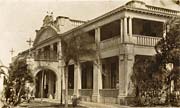
"Grand Pacific Hotel, Suva, Fiji"
Photographer Harry Gardiner. Published for him by the Rose Stereograph Company, Armadale, Victoria.
From the state of the vegetation, this photo was certainly taken after the one above, and given that it was one of Gardiner's, was probably taken in the 1920s.
"Grand Pacific Hotel, Suva, Fiji Islands". M1515
Unused postcard.Made in U.S.A. by E.C.Kropp Co., Milwaukee. No date, but perhaps from the 1930s, heyday of the GPH. (Map Ref G) The Royal reception for Queen Elizabeth's 1953 visit was held there, and she appeared on the balcony for photographers. The GPH is still in existence but since the 1980s has had mixed fortunes.
See also previous picture.
"Grand Pacific Hotel, Suva, Fiji - View (2) of Lounge looking towards Main Entrance"
Unused and undated, but probably from the 1920s to judge by the moustachioed gentleman seated on the right. Note the Indian servant all in white and wearing a (rfed) cummerbund.
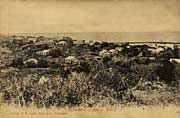
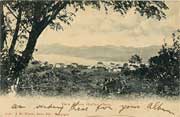
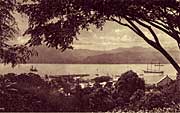
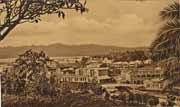
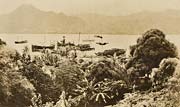

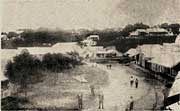
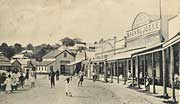
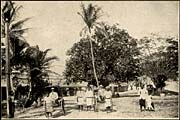
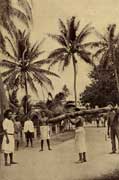
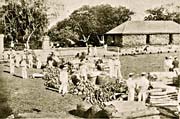
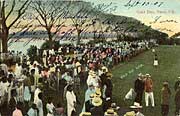
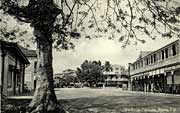
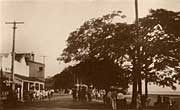
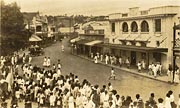
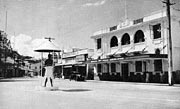

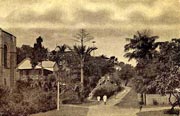
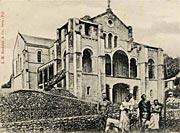

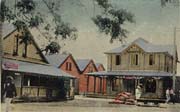
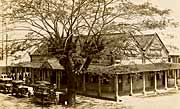
2.jpg)
